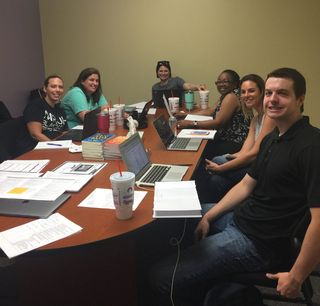“Power with people leads to commitment, dedication, and ownership. Power over people leads to resentment, compliance, and buy-in. Future Ready principals know how to use their influence to share the leadership role with others.”

Can you tell us a little about Morton Ranch Junior High?
Morton Ranch Junior High celebrates the culturally diverse backgrounds of its 1,225 students. Over half are Hispanic, 17 percent African American, approximately five percent Asian, and 20 percent White. Sixty-six percent meet criteria as economically disadvantaged, 14 percent receive special education services, and 14 percent are English Language Learners.
Morton Ranch Junior High was selected as a 2018 N2 Schools Transforming Learning recipient by the Principals’ Institute. This recognition honors and showcases the work of campuses making exceptional strides on their journeys to provide innovative learning opportunities for all students. We were also recognized as a 2019 Character.Org Promising Practice School for our work in building character and community in our school.
What does it mean for your students, staff, and administrators to be “Future Ready”?

Administrators. Shared leadership is how organizations create ownership of school goals. As we work on creating leaders at all levels, the Future Ready Principals’ Framework is a great resource. Being Future Ready means being prepared and skilled in adapting to challenges and being able to work with others in different settings.
Staff. The leadership gives clear guidance to teachers, who know that their role is to prepare students for their future, not our past. This means shifting practices and beliefs and knowing our students’ academic, social, and emotional needs so we can design learning experiences to help them grow.

Students. Students can create agency when they know how to set goals and advocate for their needs. Teaching students how to adapt to different settings and work with others prepares them for our constantly changing world. Our students practice communication skills and teamwork and build character, relationships, and community. Knowing content will always be important, but knowing how to learn and unlearn is a critical skill for Future Ready students.
What does the Future Ready framework look like in practice for you as a principal?
Curriculum, Instruction, Assessment
Teachers who are able to reflect on their own instructional practice are able to solve curriculum, instruction, and assessment challenges. Pre-assessments in math classes, for example, have helped teachers to be more intentional about meeting individual student needs. Assessment data also helps teachers teach students how to set and monitor personal goals. In other departments, teachers use protocols to examine student work. Not only has this helped teachers reflect on their practice, but it also has helped me to know where to target professional development.
Personalized Professional Learning
Our teachers set individual goals and we have instructional coaches, a video coaching platform, and other resources to help teachers meet their goals. Meeting teachers where they are and helping them grow to where they want to be is intentional, purposeful work. We also focus all professional learning on campus or departmental goals. For example, next year we’ll be focusing on literacy across the content areas. Professional learning days are integrated throughout the calendar to allow teachers time to learn, model, and share new skills.

Collaborative Leadership
Team leaders and department chairs have opportunities to learn and practice how to use different leadership strategies to help them build high-performing teams with shared commitment, responsibility, accountability, and trust. Using protocols in PLCs to structure conversation and determine outcomes helps teachers to express their thinking and learn from each other. It also allows all teachers’ voices to be heard. In addition to department chairs and other formal leadership roles, we have team leaders in every core content area and grade level as well as multiple teacher-led committees. Focus groups generate ideas and target specific areas of growth related to school-wide improvement. Students are also leaders and serve on panels and in focus groups. Our students know they have a voice. By being available and accessible to engage with students, I’m able to capture their voice and use their suggestions to help us improve.
What lessons have you learned as you’ve implemented these ideas and practices?
There’s power and energy in working with people to achieve a goal. Being a Future Ready principal requires seeing beyond your current context and working with others to create an organization that’s equipped to lead and adapt to changes. Building leadership capacity in teachers and students gives them a voice and the opportunity to lead from wherever they are in the building. Being intentional about building leadership capacity has created ownership and pride in our work together at Morton Ranch Junior High. As leaders, we can be afraid to give power away. If given the choice, would you rather have power over people or power with people? Power with people leads to commitment, dedication, and ownership. Power over people leads to resentment, compliance, and buy-in. Future Ready principals know how to use their influence to share the leadership role with others.
